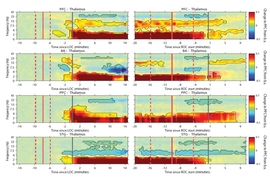About 50 million Americans suffer from chronic pain, which interferes with their daily life, social interactions, and ability to work. MIT Professor Fan Wang wants to develop new ways to help relieve that pain, by studying and potentially modifying the brain’s own pain control mechanisms.
Her recent work has identified an “off switch” for pain, located in the brain’s amygdala. She hopes that finding ways to control this switch could lead to new treatments for chronic pain.
“Chronic pain is a major societal issue,” Wang says. “By studying pain-suppression neurons in the brain’s central amygdala, I hope to create a new therapeutic approach for alleviating pain.”
Wang, who joined the MIT faculty in January 2021, is also the leader of a new initiative at the McGovern Institute for Brain Research that is studying drug addiction, with the goal of developing more effective treatments for addiction.
“Opioid prescription for chronic pain is a major contributor to the opioid epidemic. With the Covid pandemic, I think addiction and overdose are becoming worse. People are more anxious, and they seek drugs to alleviate such mental pain,” Wang says. “As scientists, it’s our duty to tackle this problem.”
Sensory circuits
Wang, who grew up in Beijing, describes herself as “a nerdy child” who loved books and math. In high school, she took part in science competitions, then went on to study biology at Tsinghua University. She arrived in the United States in 1993 to begin her PhD at Columbia University. There, she worked on tracing the connection patterns of olfactory receptor neurons in the lab of Richard Axel, who later won the Nobel Prize for his discoveries of odorant receptors and how the olfactory system is organized.
After finishing her PhD, Wang decided to switch gears. As a postdoc at the University of California at San Francisco and then Stanford University, she began studying how the brain perceives touch.
In 2003, Wang joined the faculty at Duke University School of Medicine. There, she began developing techniques to study the brain circuits that underlie the sense of touch, tracing circuits that carry sensory information from the whiskers of mice to the brain. She also studied how the brain integrates movements of touch organs with signals of sensory stimuli to generate perception (such as using stretching movements to sense elasticity).
As she pursued her sensory perception studies, Wang became interested in studying pain perception, but she felt she needed to develop new techniques to tackle it. While at Duke, she invented a technique called CANE (capturing activated neural ensembles), which can identify networks of neurons that are activated by a particular stimulus.
Using this approach in mice, she identified neurons that become active in response to pain, but so many neurons across the brain were activated that it didn’t offer much useful information. As a way to indirectly get at how the brain controls pain, she decided to use CANE to explore the effects of drugs used for general anesthesia. During general anesthesia, drugs render a patient unconscious, but Wang hypothesized that the drugs might also shut off pain perception.
“At that time, it was just a wild idea,” Wang recalls. “I thought there may be other mechanisms — that instead of just a loss of consciousness, anesthetics may do something to the brain that actually turns pain off.”
Support for the existence of an “off switch” for pain came from the observation that wounded soldiers on a battlefield can continue to fight, essentially blocking out pain despite their injuries.
In a study of mice treated with anesthesia drugs, Wang discovered that the brain does have this kind of switch, in an unexpected location: the amygdala, which is involved in regulating emotion. She showed that this cluster of neurons can turn off pain when activated, and when it is suppressed, mice become highly sensitive to ordinary gentle touch.
“There’s a baseline level of activity that makes the animals feel normal, and when you activate these neurons, they’ll feel less pain. When you silence them, they’ll feel more pain,” Wang says.
Turning off pain
That finding, which Wang reported in 2020, raised the possibility of somehow modulating that switch in humans to try to treat chronic pain. This is a long-term goal of Wang’s, but more work is required to achieve it, she says. Currently her lab is working on analyzing the RNA expression patterns of the neurons in the cluster she identified. They also are measuring the neurons’ electrical activity and how they interact with other neurons in the brain, in hopes of identifying circuits that could be targeted to tamp down the perception of pain.
One way of modulating these circuits could be to use deep brain stimulation, which involves implanting electrodes in certain areas of the brain. Focused ultrasound, which is still in early stages of development and does not require surgery, could be a less invasive alternative.
Another approach Wang is interested in exploring is pairing brain stimulation with a context such as looking at a smartphone app. This kind of pairing could help train the brain to shut off pain using the app, without the need for the original stimulation (deep brain stimulation or ultrasound).
“Maybe you don’t need to constantly stimulate the brain. You may just need to reactivate it with a context,” Wang says. “After a while you would probably need to be restimulated, or reconditioned, but at least you have a longer window where you don't need to go to the hospital for stimulation, and you just need to use a context.”
Wang, who was drawn to MIT in part by its focus on fostering interdisciplinary collaborations, is now working with several other McGovern Institute members who are taking different angles to try to figure out how the brain generates the state of craving that occurs in drug addiction, including opioid addiction.
“We’re going to focus on trying to understand this craving state: how it’s created in the brain and how can we sort of erase that trace in the brain, or at least control it. And then you can neuromodulate it in real time, for example, and give people a chance to get back their control,” she says.











